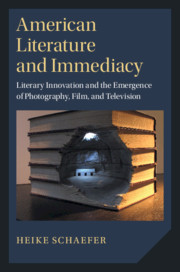 American Literature and Immediacy
American Literature and Immediacy from Part III - Literary Immediacy and Television
Published online by Cambridge University Press: 19 December 2019
The chapter analyzes how Don DeLillo’s novel Mao II critically refracts TV’s immediacy effects to explore the cultural function that literature performs within the increasingly commodified market dynamics of mass media communication. The chapter argues that DeLillo accomplishes a paradoxical feat: he tells the story of a retrograde writer who loses his life in a futile attempt to resist the commercialization of his work; yet DeLillo suffuses this allegorical tale about the death of an author in the age of mass media and consumer culture with detailed ekphrastic descriptions of TV news footage, photographs, and pop art that ultimately confirm the capacity of literature to respond in innovative ways to the predominance of visual media, the misapprehension of televisual images as real, and the increasing commodification of literature and art. Published as American culture was turning digital, the novel provides an apt terminus for my study of how American writers reworked the immediacy effects of analog new visual media to renew literary culture.
To save this book to your Kindle, first ensure [email protected] is added to your Approved Personal Document E-mail List under your Personal Document Settings on the Manage Your Content and Devices page of your Amazon account. Then enter the ‘name’ part of your Kindle email address below. Find out more about saving to your Kindle.
Note you can select to save to either the @free.kindle.com or @kindle.com variations. ‘@free.kindle.com’ emails are free but can only be saved to your device when it is connected to wi-fi. ‘@kindle.com’ emails can be delivered even when you are not connected to wi-fi, but note that service fees apply.
Find out more about the Kindle Personal Document Service.
To save content items to your account, please confirm that you agree to abide by our usage policies. If this is the first time you use this feature, you will be asked to authorise Cambridge Core to connect with your account. Find out more about saving content to Dropbox.
To save content items to your account, please confirm that you agree to abide by our usage policies. If this is the first time you use this feature, you will be asked to authorise Cambridge Core to connect with your account. Find out more about saving content to Google Drive.